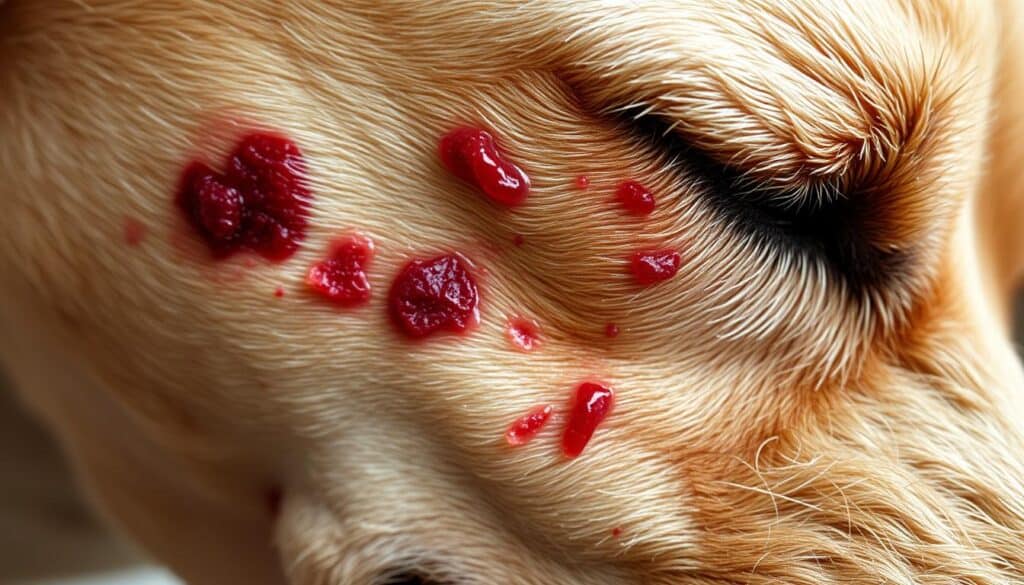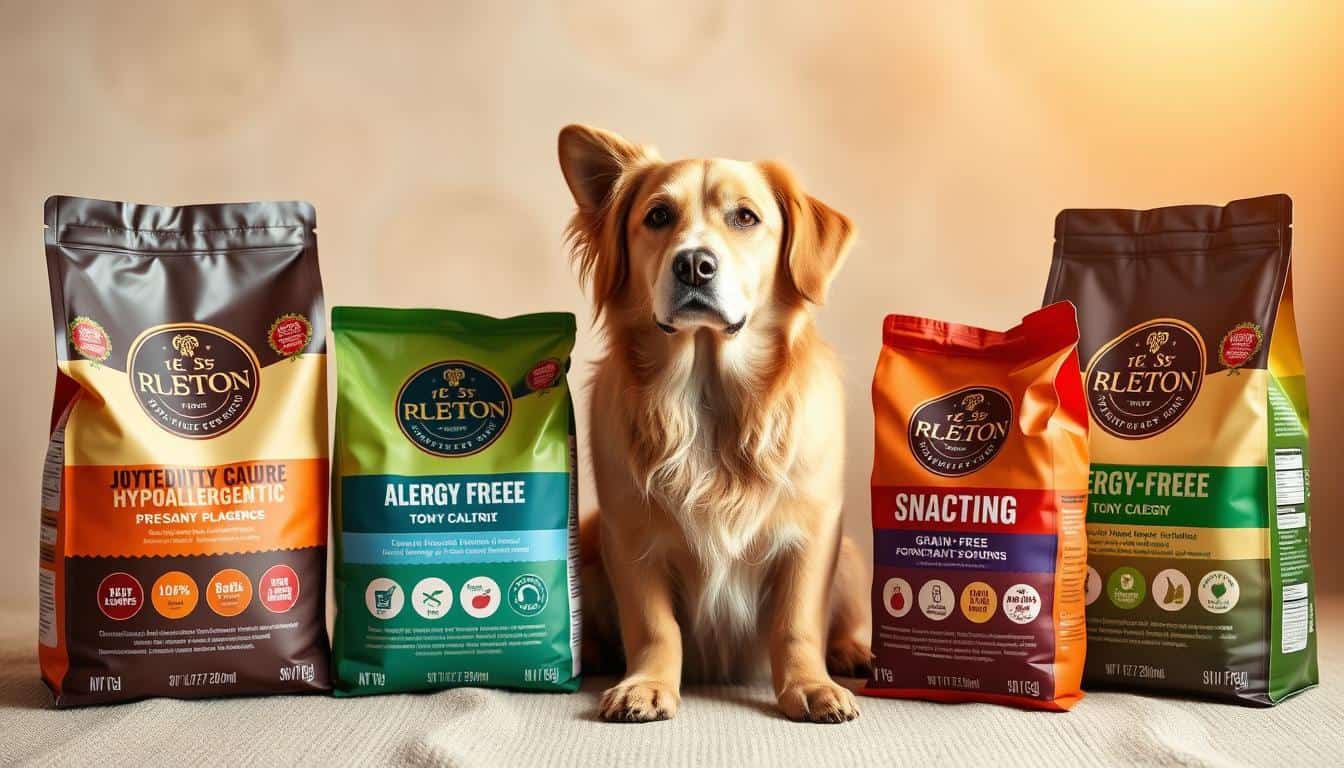Managing skin allergies in pets can be a challenging task for many owners. Symptoms like itching, redness, and discomfort often lead to frustration. Identifying the root cause is crucial, as allergies can stem from food, environmental factors, or even fleas.
This article provides vet-reviewed recommendations from Chewy’s expert panel. It emphasizes the importance of differentiating between food-related and other types of allergies. For true food-related issues, therapeutic prescription diets can make a significant difference.
Additionally, the guide includes budget-friendly and life-stage-appropriate options. These choices ensure that every pet owner can find a suitable solution for their furry companion’s needs.
Understanding Skin Allergies in Dogs

Skin allergies in dogs can stem from various sources, making identification tricky. These reactions often cause discomfort and require careful attention to pinpoint the exact cause. Allergens can be environmental, flea-related, or even tied to certain foods.
Common Causes of Skin Allergies
Environmental triggers like pollen and dust mites are primary culprits. These substances can lead to persistent itching and irritation. Flea allergy dermatitis is another major concern, as even a single flea bite can cause severe itching due to the dog’s reaction to flea saliva.
Food-related allergens, such as beef, chicken, and dairy, are less common but still impactful. Identifying these triggers often requires a process of elimination and close observation.
Symptoms to Watch For
Dogs with skin allergies often show clear signs of discomfort. Redness, excessive scratching, and hair loss are common indicators. Ear infections and chronic licking are also frequent symptoms, which can lead to secondary bacterial infections if left untreated.
Recognizing these allergy symptoms early can help in managing the condition effectively and improving the dog’s quality of life.
Why Diet Matters for Dogs with Skin Allergies

Nutrition is a cornerstone of skin health for allergy-prone animals. A balanced diet strengthens the skin’s resilience against allergens, reducing discomfort and irritation. Proper nutrients support the immune system, helping pets combat external triggers more effectively.
The Role of Nutrition in Skin Health
Omega-3 and omega-6 fatty acids are essential for maintaining a healthy skin barrier. These omega fatty acids reduce inflammation and alleviate itching, providing relief for pets with sensitive skin. Including these in their diet can make a noticeable difference in their overall comfort.
Additionally, a diet rich in vitamins and minerals supports skin repair and regeneration. This helps pets recover faster from irritation caused by allergens.
How Food Allergies Develop
Food allergies occur when the immune system mistakenly identifies certain proteins as harmful. Common triggers include protein sources like chicken or beef. Unlike food sensitivities, which affect digestion, allergies trigger an immune response, leading to symptoms like itching and redness.
Identifying these triggers often requires an elimination diet supervised by a veterinarian. This process helps pinpoint the exact cause of the reaction, ensuring the pet receives the right dietary adjustments.
“Only 10% of allergy cases are true food allergies, but these often require specialized diets for effective management.”
Understanding the difference between allergies and sensitivities is crucial for providing the right care. With proper guidance, pet owners can make informed dietary choices that improve their pet’s quality of life.
Key Considerations When Choosing Dry Dog Food
Selecting the right kibble for pets with sensitivities requires careful thought. Several factors, such as allergens, life stage, and budget, play a crucial role in making the best choice. By focusing on these aspects, owners can ensure their furry companions receive the nutrition they need without triggering reactions.
Identifying Your Dog’s Allergens
Understanding what triggers reactions is the first step. Veterinary allergy testing or elimination diets can help pinpoint specific allergens. Common culprits include proteins like chicken or beef, but novel options like venison or duck may be safer for sensitive pets.
Consistency is key. Once the allergen is identified, sticking to a hypoallergenic diet can prevent flare-ups and improve the pet’s quality of life.
Life Stage and Size Considerations
Pets have different nutritional needs based on their age and size. Small breeds often benefit from smaller kibble sizes to prevent choking, while larger breeds may require formulas tailored to joint health.
Life stage-specific diets ensure pets receive the right balance of nutrients, whether they’re puppies, adults, or seniors. This tailored approach supports overall health and well-being.
Budget and Long-Term Fit
Cost is an important factor when choosing the right diet. Prescription hypoallergenic options can be 2-3 times more expensive than over-the-counter choices. However, investing in quality nutrition can reduce long-term health issues and vet visits.
Comparing premium brands like Royal Canin to budget-friendly alternatives helps owners find a balance between quality and affordability. A diet that fits both the pet’s needs and the owner’s budget ensures sustainability.
Top Ingredients to Look for in Dry Dog Food
Choosing the right ingredients can make a world of difference for pets with sensitivities. A well-balanced diet not only supports overall health but also addresses specific concerns like discomfort and irritation. Here’s what to prioritize when selecting the right formula.
High-Quality Protein Sources
Proteins are the building blocks of a healthy diet, but not all sources are equal. For pets with sensitivities, novel options like salmon, lamb, or rabbit are often safer choices. These alternatives reduce the risk of triggering reactions commonly associated with chicken or beef.
High-quality protein supports muscle development and energy levels. It also minimizes the likelihood of adverse reactions, making it a cornerstone of any hypoallergenic diet.
Omega Fatty Acids for Skin Health
Omega-3 and omega-6 fatty acids are essential for maintaining a healthy coat and sensitive skin. Ingredients like salmon and flaxseed are rich in these nutrients, helping to reduce inflammation and promote hydration.
Regular inclusion of omega fatty acids can alleviate itching and improve overall skin resilience. This makes them a must-have for pets prone to irritation.
Grain-Free vs. Limited Ingredient Diets
Grain-free formulas have gained popularity, but they’re not a universal solution. While some pets benefit from avoiding grains, others may not see a significant difference. Limited ingredient diets (LID), on the other hand, focus on simplicity by reducing exposure to common allergens.
Brands like Blue Buffalo Basics and Natural Balance offer LID options that prioritize minimal, high-quality ingredients. These diets are particularly effective for pets with multiple sensitivities.
“Limited ingredient diets simplify the process of identifying and avoiding allergens, making them a practical choice for sensitive pets.”
By understanding these options, pet owners can make informed decisions that cater to their furry companion’s unique needs.
Best Dry Dog Food for Skin Allergies: Expert Recommendations
Expert recommendations can simplify the process of selecting the ideal diet for pets with sensitivities. With so many options available, it’s essential to focus on formulas that address specific needs while providing balanced nutrition. Here are some top choices vetted by professionals.
Top Brands for Allergy-Prone Dogs
When it comes to managing reactions, certain brands stand out for their quality and effectiveness. Hill’s Science Diet offers a formula designed for sensitive stomachs and skin, enriched with prebiotic fiber and omega-6 fatty acids. This blend supports digestion and promotes a healthy coat.
Blue Buffalo Basics is another excellent choice, featuring a limited ingredient diet with deboned turkey and potatoes. This simplicity reduces the risk of triggering reactions, making it a safe option for pets with multiple sensitivities.
Product Reviews and Key Features
For pets with severe reactions, Purina Pro Plan Veterinary Diets HA Hydrolyzed is a highly recommended option. Its hydrolyzed protein minimizes the risk of immune responses, providing relief for pets with intense discomfort.
Wellness Simple LID with lamb and oatmeal is another standout. This formula focuses on gentle digestion and is free from common allergens like grains and artificial additives. Many pet owners report noticeable improvements in their pets’ comfort within weeks of switching.
“Switching to a hypoallergenic diet transformed my pet’s life. The itching stopped, and his coat became shinier than ever.” – A satisfied pet owner
These expert-recommended options ensure that pets with sensitivities receive the care they deserve. By choosing the right formula, owners can provide relief and improve their furry companion’s quality of life.
Specialized Formulas for Specific Needs
Certain breeds and conditions demand tailored nutrition to thrive. While general hypoallergenic diets help many pets, some require formulas targeting yeast overgrowth or breed-specific sensitivities. These specialized options address root causes, offering relief where standard kibble falls short.
Dry Dog Food for Dogs with Yeast Infections
Yeast thrives on sugars, making low-carb diets critical for pets prone to infections. Taste of the Wild Pacific Stream uses salmon and sweet potatoes—low-glycemic ingredients that starve yeast while providing essential nutrients.
For severe cases, Zignature Kangaroo Formula offers a novel protein source, reducing immune triggers. Its limited ingredients minimize flare-ups, making it ideal for sensitive pets.
Best Options for Pitbulls with Skin Allergies
Pitbulls often need high-protein diets enriched with zinc and vitamin E. These nutrients strengthen skin barriers and reduce irritation. Bully Max High Performance combines 30% protein with added zinc, supporting muscle and skin health simultaneously.
Grain-inclusive options like Purina Pro Plan Sensitive Skin can also work if grains aren’t triggers. Always consult a vet to identify the right balance for your pet’s needs.
“Switching to a kangaroo-based diet resolved my dog’s chronic yeast issues within weeks.”
Homemade Alternatives to Commercial Dog Food
Preparing meals at home gives pet owners full control over what goes into their companion’s bowl. This approach is especially valuable for pets with dietary sensitivities, as it eliminates unknown allergens found in processed kibble. With careful planning, homemade diets can deliver balanced nutrients tailored to individual needs.
Why Choose Homemade Meals?
Customization is the biggest advantage. Owners can select novel proteins like turkey or duck, avoiding common triggers. Fresh ingredients also retain more natural vitamins, supporting skin and coat health.
However, veterinary guidance is crucial. A pet nutritionist can ensure recipes include essentials like calcium and omega-3s, preventing deficiencies.
Simple Hypoallergenic Recipe
Try this turkey and quinoa stew for sensitive pets:
- 1 cup cooked ground turkey (lean)
- ½ cup quinoa (rinsed)
- 1 cup spinach (chopped)
- 1 tbsp flaxseed oil (for fatty acids)
Mix ingredients and serve cooled. Adjust portions based on your pet’s size and activity level.
“After switching to homemade meals, my dog’s itching stopped within three weeks. Her coat is now glossy and soft.”
While cost-effective, homemade diets require time and research. Skipping key nutrients like taurine or zinc can harm health. Always consult a professional before making dietary changes.
How to Transition Your Dog to New Food
Switching your pet’s diet requires a careful approach to avoid discomfort. A sudden change can lead to digestive upset, making a gradual transition essential. This process ensures your pet’s health remains stable while adapting to the new diet.
Step-by-Step Transition Plan
Start by mixing 25% of the new kibble with 75% of the old food. Over the next 7-10 days, gradually increase the ratio until your pet is eating 100% of the new formula. This slow transition minimizes the risk of gastrointestinal issues like diarrhea or vomiting.
Adding probiotics during this period can ease digestion. These supplements support gut health, making the switch smoother for your pet. Patience is key, especially if your pet is a picky eater.
Monitoring Your Dog’s Response
Keep a journal to track any changes in your pet’s behavior or symptoms. Note stool quality, energy levels, and signs of itching. If diarrhea or vomiting occurs within 48 hours, it may indicate food intolerance.
Consult your veterinarian if adverse reactions persist beyond two weeks. They can help identify underlying issues and recommend adjustments to the diet. Regular monitoring ensures your pet’s transition is safe and effective.
“A gradual switch to new food not only prevents discomfort but also helps pets adapt more easily.”
Empowering Your Dog’s Health Through the Right Diet
Tailored nutrition plays a pivotal role in supporting a pet’s overall well-being. For pets with sensitivities, the right diet can alleviate discomfort and improve their quality of life. Combining dietary changes with environmental adjustments, such as reducing exposure to allergens, creates a holistic approach to managing symptoms.
In severe cases, collaboration with a vet is essential. They can guide owners in identifying triggers and recommending specialized formulas. This partnership ensures pets receive the care they need to thrive.
By focusing on tailored nutrition and proactive care, owners can empower their pets to live happier, healthier lives. For personalized advice, consult Chewy’s vet team to find the perfect solution for your furry companion.





